SQL - 01 Relating
Databases can have multiple tables.
sqlite longlist.db
.tables is command used to view all the tables in the database.
When there are some relationship between these tables, we call them relational database. examples would be, Authors write books, publishers publish books, books are translated by translators.
The basic approach of organizing two or more tables can be using the honor system where the first row of one table will always correspond to the first row of another table. But there are possibility of mistakes in organizing it in this way. One table approach could solve this but can lead to redundancy (duplication of data) if there are one to many relationship between columns.
Entity Relationship Diagram
One to one (author writes a book) One to many (author writes many books) Many to many (few authors together wrote many books) These can be visualized using an entity relationship (ER) diagram.
Each table is an entry in our database. The relationship between the tables or entities are represented by the verbs that mark the lines connecting entries.
Crow’s foot notation. The first line with zero on the line indicates that there are no relations. Second one means it should at least have one row that relates to it in the other table. Third with many branches means that the entity is related to many rows from another table.


One book is written by one author, also one author writes one book.
The author writes at least one book and a book is at least written by one author. The author could be associated with one or multiple books same for books.

Keys
To relate tables to one another.
Primary Keys
ISBN is a unique identifier given to all books to make it easy to search and identify. Similarly, Primary key (like ISBN) is an identifier that is unique for every item in the table. Each ID given within different tables (authors, books, publishers) would be the primary key of the table it belongs to.
Foreign Keys
A foreign key is a primary key taken from a different table. By referencing the primary key of a different table, it helps relate the tables by forming a link between them.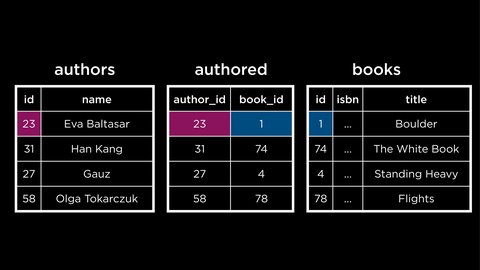
Representing the many to many relationship using foreign keys in authored table that maps the primary keys of books (book_id) to the primary key of authors (author_id)
The tables like authored are called joint or junction tables.
Subqueries
A subquery is a query inside another query. also called nested queries which allows for making the queries more dynamic when many id or names have to be accessed.
SELECT "title"
FROM "books"
WHERE "publisher_id" = (
SELECT "id"
FROM "publishers"
WHERE "publisher" = 'Fitzcarrlado Edition'
);In this one to many relationship where a publisher has many books. To find the title of the books from a publisher, we need the publisher id. To get the publisher_id we have to search for matching name in publishers table.
The subquery in the parentheses will be run first, or the deepest one will be. The indentation is just a styling convention.
To find rating of a book in memory of memory
SELECT "rating"
FROM "ratings"
WHERE "book_id" = (
SELECT "id"
FROM "books"
WHERE "title" = 'In Memory of Memory'
);Averaging the ratings by putting the rating in average
SELECT AVG("rating")
FROM "ratings"
WHERE "book_id" = (
SELECT "id"
FROM "books"
WHERE "title" = 'In Memory of Memory'
);For a many-to-many relationships where there is a join table which has just the ID, there will be many nested queries. To find the author(s) of book Flights
SELECT "name"
FROM "authors"
WHERE "id" = (
SELECT "author_id"
FROM "authored"
WHERE "book_id" = (
SELECT "id"
FROM "books"
WHERE "title" = 'Flights'
)
);IN
This is the keyword used to check whether the desired value in in a given set of values.
The relationship between the authors and books is many to many. This means there can be one or more authors for a book.
To find the names of all the books written by an author, we would use IN keyword.
SELECT "title"
FROM "books"
WHERE "id" IN (
SELECT "book_id"
FROM "authored"
WHERE "author_id" = (
SELECT "id"
FROM "authors"
WHERE "name" = 'Fernanda Melchor'
)
);Innermost query uses = because we want to find the author by his name.
IN is used as the authored table might give many book_id as a set.
So searching In that to find all the id if they are present in books.
JOIN
This allows to combine two or more tables together.
We can join the tables using a common factor between the two tables (like id) to ensure correct rows are lined up against each other.
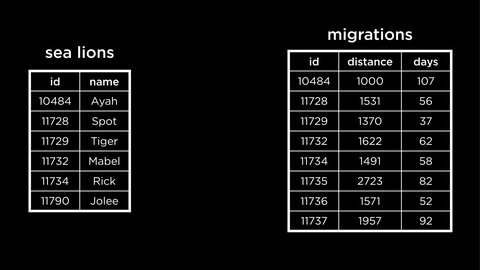
To join these two tables:
SELECT *
FROM "sea_lions"
JOIN "migrations" ON "migrations"."id" = "sea_lions"."id";The ON keyword is used to specify which values match between the tables being joined. (there is no way to join tables without matching values).
INNER JOIN
Inner join happens when there is an id in one table which isn’t present in another table so these rows will get removed from the joined table.
Only the rows which have their id match will be present. like the example above where just the JOIN…ON is used is an inner join.
OUTER JOIN
This allows for some data which doesn’t match also to be kept. leading to NULL values when joined.
LEFT JOIN prioritize the data in the left (first) table.(keeps all the rows from first table)
RIGHT JOIN prioritize the data in the right(second) table and keeps all rows of second table.
FULL JOIN allows to see the entries of all the tables.
SELECT *
FROM "sea_lions"
LEFT JOIN "migrations" ON "migrations"."id" = "sea_lions"."id";NATURAL JOIN
If the values on which we are joining the two tables have the same column name in both tables, we can omit the ON section.
This will be an INNER JOIN and also there will be no duplicate ID columns.
SELECT *
FROM "sea_lions"
NATURAL JOIN "migrations";Sets
On running a query, the results we see are called result set, which is a kind of set in SQL.
INTERSECT
Intersection of two sets (author, translator) when a person is in both.
This can be done by using INTERSECT operations.
SELECT "name" FROM "translators"
INTERSECT
SELECT "name" FROM "authors";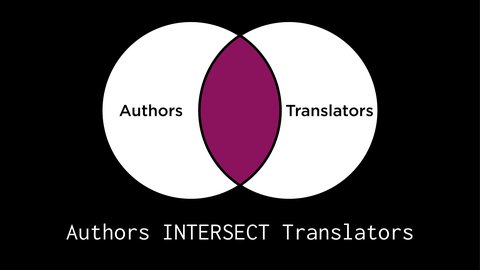
UNION
If a person is either an author or translator or both, then they belong to the union of the two sets. So every author and translator is included but only once in this result.
SELECT "name" FROM "translators"
UNION
SELECT "name" FROM "authors";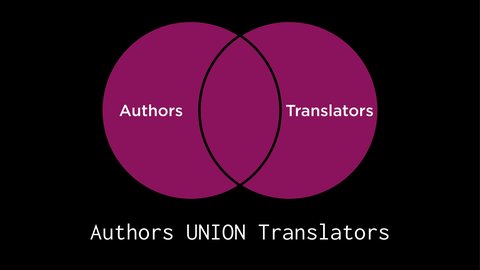
To get profession of person in result,
SELECT 'author' AS "profession", "name"
FROM "authors"
UNION
SELECT 'translator' AS "profession", "name"
FROM "translators";EXCEPT
Everyone who is only an author using EXCEPT.
Which means the set of translators is subtracted from authors.
SELECT "name" FROM "authors"
EXCEPT
SELECT "name" FROM "translators";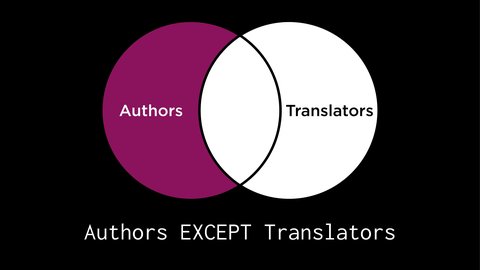
INTERSECT
To find people who are either authors or translators but not both.
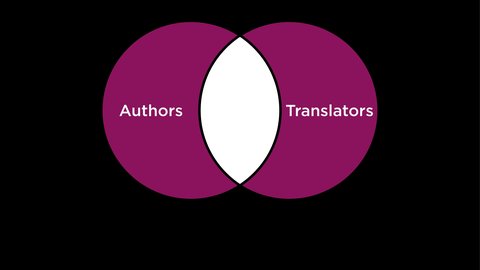
These are useful to answer many different questions.
Each nested query finds the ID’s of the books for one translator.
The INTERSECT is used to intersect the resulting two sets to give the books both have collaborated on.
SELECT "books_id" FROM "translated"
WHERE "translator_id" = (
SELECT "id" FROM "translators"
WHERE "name" = 'Sophie'
)
INTERSECT
SELECT "books_id" FROM "translated"
WHERE "translator_id" = (
SELECT "id" FROM "translators"
WHERE "name" = 'Margaret'
);We have to make sure to have same number and type of columns in the sets to be combined using INTERSECT UNION etc
Groups
We want to find the average rating if the book. First need the group ratings together by the book and then average the ratings out for each books(each group)
SELECT "book_id", AVG("rating") AS "average ratings"
FROM "ratings"
GROUP BY "book_id";In this query, GROUP By was used to create groups for each book and then collapse the ratings of the group into an average rating!
To see the books that are rated with average rating of over 4.
SELECT "book_id", ROUND(AVG("rating"), 2) AS "average rating"
FROM "ratings"
GROUP BY "book_id"
HAVING "average rating" > 4.0;HAVING is used here to specify a condition for the groups, instead of WHERE (which specifies conditions for individual rows)
Ordering the books according the the rating
SELECT "book_id", ROUND(AVG("rating"), 2) AS "average rating"
FROM "ratings"
GROUP BY "book_id"
HAVING "average rating" > 4.0
ORDERE BY "average rating" DESC;To get the number of rating for each book
SELECT "book_id", COUNT("rating")
FROM "ratings"
GROUP BY "book_id";